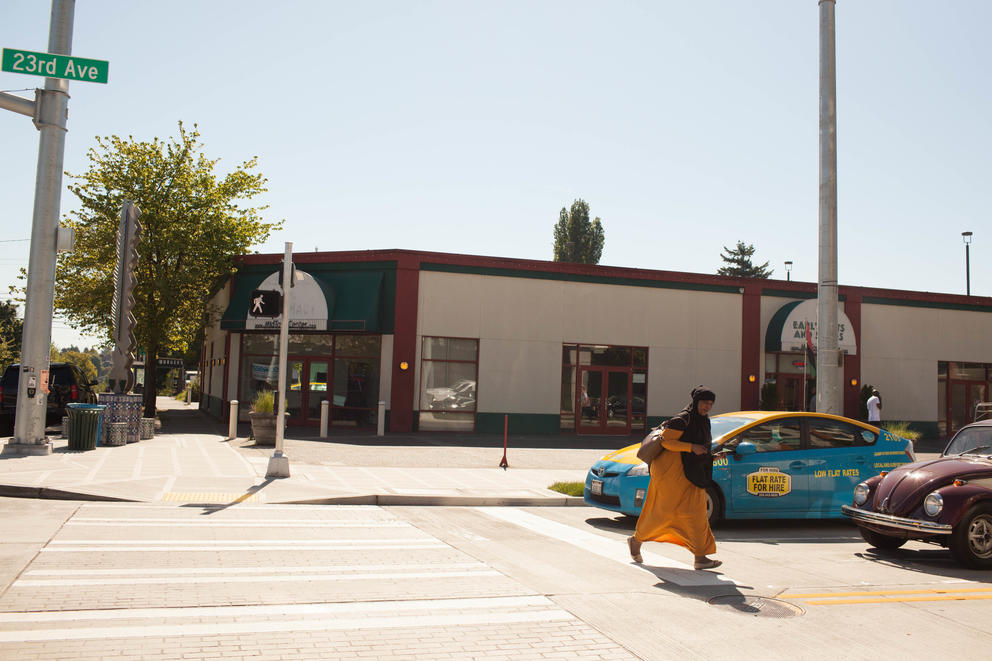The 2.5-acre plot on the southeast corner of 23rd Avenue and East Union Street in Seattle’s Central District — once a cornerstone of historic black Seattle and now a symbol of displacement and gentrification – has been purchased for just over $23 million. It’s a partnership between Lake Union Partners, the urban and rural preservation organization Forterra and Africatown Community Land Trust, an advocacy organization to acquire land for Seattle's African American population.
The development deal will result in more than 200 affordable housing units and represents an experiment for preventing further displacement and testing the limits of the affordable housing requirement mandated to for-profit developers.
Is this a model that can be replicated elsewhere? And if the city had demanded more affordable housing, would this project have happened at all?
Lake Union Partners, the local development company that currently has several projects throughout the city including on both the southwest and northwest corners of 23rd and Union, will turn a profit with this most recent acquisition. While that fact may make some squeamish, for Africatown’s Wyking Garrett and Kenny Pleasant, who have been at the forefront of combatting the gentrification of the neighborhood, it's okay.
“There’s a negative stigma of developers,” says Pleasant, an Africatown board member. He’s sitting in a 22nd floor downtown Seattle conference room – a conference room belonging to Forterra, Africatown's development deal partner.
“You hear it sometimes in community meetings: a for-profit developer is some bad conglomerate of bad people with bad intentions when that’s not the case.”
The Midtown Center, as the current development is known, is one of Seattle's remaining centers for black-owned business: a barbershop, a hair salon, a liquor store, all which have been there for decades. Thompson's Point of View across the street, once a longtime staple in the black community, is now a hipster hangout spot called The Neighbor Lady. Next door stands the hugely successful Uncle Ike's legal pot shop, an in-your-face reminder of the many young black men arrested on the same corner for selling weed when it was illegal.
These tense reminders of the Central District's gentrification have spurred protests, especially against Uncle Ike's. It is with this in mind that Lake Union Partners proceeded with their Africatown/Forterra partnership.
As part of its deal, Lake Union Partners will quickly turn around and sell twenty percent of the parcel to Forterra. Forterra will then work with Africatown, which has been the most vocal organization when it comes to preserving an African-American presence in the Central District. Forterra and Africatown will then construct 125 units of affordable housing.
The remaining 80 percent of the property will be redeveloped by Lake Union Partners. New city policies currently under consideration will require 10 percent of the new development project be affordable housing. In exchange, Lake Union Partners will get to build their project an extra 25 to 35 feet higher, which will make this project more profitable.
The group will also participate in a longstanding, voluntary tax credit granted to developers who set aside affordable units for families.
All told, in addition to the 125 units set aside by Africatown, Lake Union Partners will add close to another 125 affordable units, making nearly half of the approximately 500-unit development affordable.
The African-American population is being pushed out of Seattle as housing costs rise and housing stock slims. The once majority black Central District is now down to only 20 percent, according to 2014 census data.
While simply building affordable units does not guarantee housing for Seattle’s rapidly vanishing black community, the hope from the development partner is to create more options for those who have been priced out of their homes.
This land deal is exactly the kind of pro-development, pro-density, pro-affordable housing project Mayor Ed Murray and his Housing Affordability and Livability Agenda imagined back in 2015 when housing advocates and developers signed off on a bargain to trade larger buildings for more affordable housing.
The Central District is next up to have these recommendations implemented by the Seattle City Council, something Lake Union Partners is assuming will happen. With the council's approval, development in this area will likely go from 40 feet to 65 feet and developers will be required to make 10 percent of their buildings affordable or contribute to a housing fund. Add in the Africatown partnership that will work to create space for black-owned businesses and everyone, in theory, goes home happy.
But this happy sounding story will almost certainly run up against the ingrained skepticism toward for-profit developers, especially by those who think Seattle should mandate they contribute more affordable housing than the mayor’s housing deal requires.
For Garrett, Africatown's president, and Pleasant, an investment banker, selling the idea that a developer — even a local one — can make money and also help the community will almost certainly not come easy. When asked if he expected it to be difficult, Pleasant answered, “For sure. We haven’t even begun to do the convincing. We have quite the work to do ahead of us.”
Many housing advocates have called on the city to make developers dedicate 25 percent of their buildings to affordable housing; Jon Grant and Nikkita Oliver have made it part of their campaigns for elected office.
But according to Joe Ferguson, a principal partner with Lake Union Partners, anything higher than 10 percent would have prevented the Midtown project from going forward. “From our perspective it would be extremely difficult to go above that, still make this partnership work and still have a viable project,” he said. Even the 10 percent threshold, he continued, means they will have less parking than they might otherwise build.
This is the balancing act the city faces when it comes to creating more affordable housing: How to require something of developers but not in a way that will discourage them from building.
Although Africatown and Forterra will own 20 percent of the project, they will share design and contracting teams with Lake Union Partners. Garrett says it’s not yet clear what sort of community programming or businesses will go into the Africatown space. The hope is it could be an incubator for small, black-owned businesses. The timeline is still up in the air, but the plan, for now, is to begin design review by this fall. Again, this is assuming the council approves proposed changes to the building heights and affordable housing mandates in the Central District.
For Doris Koo who is consulting with the Yesler Community Collaborative, which helped facilitate this partnership, this same approach could be used in other displacement prone neighborhoods such as Little Saigon or First Hill. There are communities that would like to purchase land on their own, she said, but they can't compete with large-scale developers. And conversely, developers often face protests when they enter a neighborhood they may not have a relationship with. Partnerships like these can solve both problems, said Koo.
It’s difficult, to be sure. But Pleasant thinks the challenge will pay off. "Historically we’re not at the table," he says. But on this project, "We’re at the table."
—
This series is made possible with support from Comcast. The views and opinions expressed in the media, articles, or comments on this article are those of the authors and do not reflect or represent the views and opinions held by Comcast.




